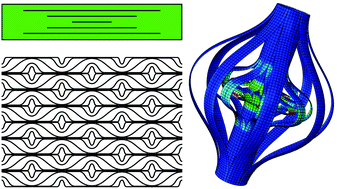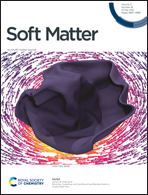Fractal-inspired soft deployable structure: a theoretical study†
Abstract
The study of soft deployable structures is an emergent field that is highly correlated with metamaterial design, soft robotics, medical devices, etc. This paper studies a novel two-dimensional (2D) soft deployable structure that has a fractal layout with hierarchically coupled thin walls, which buckles upon actuation and deforms into a “peacock tail” pattern that is over 10 fold its original dimension. Large deflection theory and finite-element (FE) modeling are used to characterize its mechanical performance and to investigate its potential application in multiple fields. Further, 2D FE homogenization is implemented to extend the novel design into an active plane lattice metamaterial, on which parametric studies are carried out to explore its effective stiffness and large strain properties. The results show that, besides excellent deformability, the “peacock tail” soft deployable structure and its lattice metamaterial derivates exhibit intriguing properties such as multi-stiffening, strong anisotropy, zero/negative Poisson's ratio, a unique post-buckling collapse mechanism, etc. Three-dimensional generalization of the fractal compliant system is modeled to elaborate on the practical use of the structures. This paper aims to enrich the spectrum of soft deployable structures, shedding light on the research of novel soft robots, hierarchical structures, and metamaterials.



 Please wait while we load your content...
Please wait while we load your content...